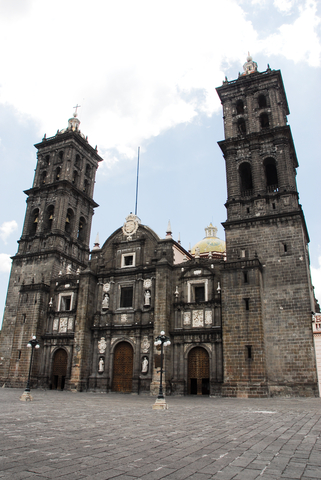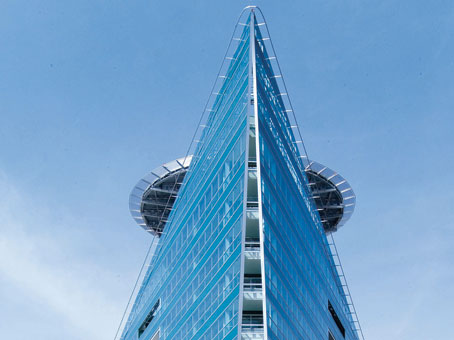
[Updated Oct 2020] A guide to serviced offices and office space for rent in Puebla as well as general information that may be useful if you are considering renting office space in the city.
For further Puebla offices information or to search office space to rent in Puebla just click. Or contact us for any office space search query.
History & Geography
Puebla is one of the most important colonial Spanish cities in Mexico as well as being one of the most beautiful. The city is located to the south of the country in the valley of Puebla flanked by the Popocatepetl and Iztaccihuatl volcanoes. To the north of the city is the dormant volcano of La Malinche and to the south is Pico de Orizaba. The Atoyac River also runs through the area, as well as the Alseseca and San Francisco rivers. The area around Puebla has been inhabited by humans for thousands of years and the Puebla Valley is littered with prehistoric remains. Among the people who inhabited the area were the Totonacas, Mazatecos and Otomi. But by the 15th century, the area was dominated by the Itzocan and Tepeaca populations. The city of Puebla was founded by the Spanish colonists on April 16th 1531 and immediately became an important stop on the route from Mexico City to Veracruz. Puebla grew quickly fuelled by the popularity of its busy markets which brought tradesman from all over the region. By the end of the 16th century, Puebla took up 120 blocks and was the second most important city in the colony of New Spain. The city continued its rapid expansion and in 1714 a new city hall was constructed. In 1827 Mexico gained its independence from Spain and all Spaniards were expelled from the city. During the Mexican American war Puebla was occupied by US forces under General Winfield Scott, but the Americans withdrew after the Treaty of Guadalupe Hidalgo was signed in 1848. During the Mexican Revolution, Puebla was under the control of the Zapatistas but was not the scene of major fighting. During the 20th century, the population of Puebla was swelled by immigration as well as the prosperity of the city, the borders of which also expanded. Today Puebla is the fourth largest city in Mexico and is a centre for education and the arts.
Economy
Traditionally Puebla benefited from a mainly agrarian economy. Among the main crops grown are corn, beans, wheat, oats, avocados, pears and white sapotes. However, while the agricultural industry is still present in the region it is no longer the main industry of the city. Approximately 80 percent of Puebla’s economy comes from the industry located mostly around the outskirts of the city. Among the products are chemicals, basic metals, textiles and electrical items. Volkswagen runs a large plant in Puebla and is a major employer in the city. The amount of German immigrants to Puebla in the late 19th and early 20th century is what prompted the carmaker to open its plant in the city. Recently food processing has become a growing part of the economy and employs several thousand residents of the city. In the last few years industry has been consolidating into several large industrial zones and parks such as the new Puebla 2000 Industrial Park and the older 5 de Mayo Industrial Park.
Tourism & Culture
Puebla is most famous for its architecture. The city has been dubbed a UNESCO World Heritage Site because of its array of varying styles of architecture. Much of the city has been designed in the ‘Mexican Baroque’ style and there are hundreds of old churches, squares and villas dotted around Puebla. In particular, the city is well known for its cathedral, dating from the 16th century. Other notable buildings include the Biblioteca Palafoxiana, the town library dating from the 17th century, Casa del Dean, the city’s oldest house, and the Museo de la Revolucion, the city’s museum of the Mexican Revolution, which is housed in the former home of political activist Aquiles Serdan. Many visitors to Puebla also visit the city’s forts, Fort Guadalupe and Fort Loreto, both dating from the 19th century. Puebla is also famous for its cuisine, especially mole poblano, a spicy sauce most often served over chicken or turkey. Mole poblano is so popular it has been called the national food of Mexico. The city is also renowned for its fine pottery and ceramics. The Talavera style especially has gained the city fame. Because there is a lot of natural clay in the region many artisans have been attracted to live and work in Puebla.
Transportation
The Hermanos Serdan International Airport serves the city of Puebla. The airport is an alternate airport for Mexico City and provides flights around Mexico as well as to the United States. Currently, a new terminal is being built to handle more international flights. The city also has an extensive bus system but has also been deemed one of the most walkable cities in the country. Recently Puebla instituted a system of pink taxis exclusively for the use of women and driven by women in order to deter assaults.

Office space for rent in Puebla
The Mexican economy has recovered strongly from the financial crisis and has been growing well during the last few years. The country’s GDP grew by four percent in 2011 and there is every indication that this number will continue to rise. Puebla’s office market is dwarfed by that of its neighbour, Mexico City. Mexico City has far more Grade A office space and is the headquarters of many major Mexican companies. Puebla has cheaper rents and good infrastructure, including an airport with regular flights to the US. However, the city suffers from a lack of Grade A office space and there are few development projects in the pipeline.
Our office space search, advisory and acquisition services are FREE, always. Our Puebla office agents and brokers are globally regulated by the Royal Institution of Chartered Surveyors (RICS) ensuring the highest standards of commercial property advice and service at all times.
